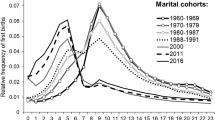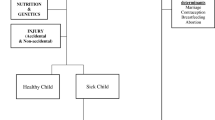Abstract
Anecdotal evidence in sub-Saharan Africa (SSA) suggests that it is unlikely for marriages with children to break up, especially when the children are male. To provide new empirical evidence, this study was conducted to investigate the effect of premarital birth and sex composition of children on marital instability (divorce or separation) among ever-married women in SSA. Data from a weighted sample of 205,997 women from Demographic and Health Surveys conducted in 26 sub-Saharan African countries between 2011 and 2014 were analysed. Stratified by sub-region, analysis involved the use of descriptive statistics and multiple logistic regression models with robust standard errors. Parity-specific logistic regression models were fitted to investigate the association between sex composition and marital instability at parities 1, 2, 3 and 4+. The percentage of women with experience of marital instability in the four sub-regions was: Western (4.6%), Central (12.0%), Eastern (10.5%) and Southern Africa (11.4%). Premarital birth was significantly associated with marital instability in Western (OR = 1.52, p < 0.05), Central (OR = 1.22, p < 0.05), Eastern (OR = 1.39, p < 0.05) and Southern Africa (OR = 1.25, p < 0.05). In Western Africa, at parities 1–2, women with female children were significantly more likely to be divorced or separated. At parities 3 and above, there was no significant difference in the odds of marital instability between women with majority male and those with majority female children. This study extends current knowledge about family dynamics by providing a wider view on the relationship between premarital birth, children’s sex composition and marital instability in the four sub-regions of sub-Saharan Africa.
Similar content being viewed by others
References
Amato, P. R. (2010). Research on divorce: Continuing trends and new developments. Journal of Marriage and Family, 72(3), 650–666.
Andersson, G., & Woldemicael, G. (2001). Sex composition of children as a determinant of marriage disruption and marriage formation: Evidence from Swedish Register Data. Journal of Population Research. doi:10.1007/BF03031886.
Anglewicz, P., & Reniers, G. (2014). HIV status, gender, and marriage dynamics among adults in Rural Malawi. Studies in Family Planning, 45(4), 415–428. doi:10.1111/j.1728-4465.2014.00005.x.
Arnold, F. (1997). Gender preferences for children. DHS Comparative Studies No. 23. Calverton, Maryland, USA: Macro International.
Becker, G. S., Landes, E., & Michael, R. T. (1977). An economic analysis of marital instability. Journal of Political Economy. doi:10.1086/260631.
Bose, S., & South, S. J. (2003). Sex composition of children and marital disruption in India. Journal of Marriage and Family, 65(4), 996–1006. doi:10.1111/j.1741-3737.2003.00996.x.
Caldwell, J. C., & Caldwell, P. (1987). The cultural context of high fertility in sub-Saharan Africa. Population and Development Review, 13(3), 409–437. doi:10.2307/1973133.
Clark, S., & Brauner-Otto, S. (2015). Divorce in sub-Saharan Africa: Are unions becoming less stable. Population and Development Review, 41(4), 583–605.
Dahl, G. B., & Moretti, E. (2008). The demand for sons. The Review of Economic Studies, 75(4), 1085–1120. doi:10.1111/j.1467-937X.2008.00514.x.
Diekmann, A., & Schmidheiny, K. (2004). Do parents of girls have a higher risk of divorce? An eighteen-country study. Journal of Marriage and Family, 66(3), 651–660. doi:10.1111/j.0022-2445.2004.00044.x.
Dommaraju, P. (2008). Marriage age and fertility dynamics in India. DHS Working Papers No. 52. Calverton, Maryland, USA: Macro International.
Durkheim, E. (1933). The division of labour in society. London: Macmillan.
Fuse, K. (2010). Variations in attitudinal gender preferences for children across 50 less-developed countries. Demographic Research, 23(36), 1031–1048.
Gage-Brandon, A. J. (1992). The polygyny-divorce relationship: A case study of Nigeria. Journal of Marriage and Family, 54(2), 285–292. doi:10.2307/353060.
Garenne, M. (2014). Trends in marriage and contraception in sub-Saharan Africa: A longitudinal perspective on factors of fertility decline. DHS Analytical Studies No. 42. Rockville, Maryland, USA: ICF International.
Garenne, M., & Zwang, J. (2006a). Premarital fertility and ethnicity in Africa. DHS Comparative Reports No. 13. Calverton, Maryland, USA: Macro International.
Garenne, M., & Zwang, J. (2006b). Premarital fertility in Namibia: Trends, factors and consequences. Journal of Biosocial Science, 38(2), 145–167. doi:10.1017/s0021932005007261.
Garenne, M., & Zwang, J. (2008). Premarital fertility and HIV/AIDS in sub-Saharan Africa. African Journal of Reproductive Health, 12(2), 64–74.
Grant, M. J., & Soler-Hampejsek, E. (2014). HIV risk perceptions, the transition to marriage, and divorce in Southern Malawi. Studies in Family Planning, 45(3), 315–337. doi:10.1111/j.1728-4465.2014.00394.x.
Hollander, D. (2004). Indian women who have daughters but no sons face an increased risk of marital dissolution. International Family Planning Perspectives, 30(1), 48–49.
Hosegood, V. (2009). The demographic impact of HIV and AIDS across the family and household life-cycle: Implications for efforts to strengthen families in sub-Saharan Africa. AIDS Care, 21(S1), 13–21. doi:10.1080/09540120902923063.
Hosegood, V., McGrath, N., Herbst, K., & Timaeus, I. M. (2004). The impact of adult mortality on household dissolution and migration in rural South Africa. Aids, 18(11), 1585–1590.
Ibisomi, L. D. G., & De Wet, N. (2014). The dynamics of household structure in sub-Saharan Africa. In C. O. Odimegwu & J. Kekovole (Eds.), Continuity and change in Sub-Saharan African demography. New York: Taylor & Francis.
Isiugo-Abanihe, U. C. (1994). Reproductive motivation and family-size preferences among Nigerian men. Studies in Family Planning, 25(3), 149–161. doi:10.2307/2137941.
Isiugo-Abanihe, U. C. (1998). Stability of marital unions and fertility in Nigeria. Journal of Biosocial Science, 30(1), 33–41.
Lehrer, E. L. (2008). Age at marriage and marital instability: Revisiting the Becker–Landes–Michael hypothesis. Journal of Population Economics, 21(2), 463–484.
Leigh, A. (2009). Does child gender affect marital status? Evidence from Australia. Journal of Population Economics, 22(2), 351–366.
Lundberg, S. (2005). Sons, daughters, and parental behaviour. Oxford Review of Economic Policy, 21(3), 340–356. doi:10.1093/oxrep/gri020.
Merrill, D., & Casterline, J. (1989). Children’s gender and marital dissolution: evidence from developing countries. (pp. 24,-[23] p.): [Unpublished] 1989. Presented at the Annual Meeting of the Population Association of America, Baltimore, Maryland, March 30–April 1, 1989.
Milazzo, A. (2014). Son preference, fertility and family structure: Evidence from reproductive behavior among Nigerian women. Policy Research Working Paper 6869. Washington DC: The World Bank.
Morgan, S. P., Lye, D. N., & Condran, G. A. (1988). Sons, daughters, and the risk of marital disruption. American Journal of Sociology. doi:10.1086/228953.
Raley, S., & Bianchi, S. (2006). Sons, daughters, and family processes: Does gender of children matter? Annual Review of Sociology, 32(1), 401–421. doi:10.1146/annurev.soc.32.061604.123106.
Rossi, P., & Rouanet, L. (2015). Gender preferences in Africa: A comparative analysis of fertility choices. World Development, 72, 326–345. doi:10.1016/j.worlddev.2015.03.010.
Subaiya, L., & Johnson, K. (2008). What’s in the gap? Factors associated with the interval between age and first sex and age at first marriage in Cameroon and their implications for reproductive health and women’s empowerment. DHS Working Papers No. 43. Calverton, Maryland, USA: Macro International.
Takane, T. (2009). Disparities and diversities among female-headed households in rural Malawi after 20 years of economic liberalization. Singapore Journal of Tropical Geography, 30, 358–372.
Takyi, B. K. (2001). Marital instability in an African Society: Exploring the factors that influence divorce processes in Ghana. Sociological Focus, 34(1), 77–96.
Takyi, B. K., & Broughton, C. L. (2006). Marital stability in sub-Saharan Africa: Do women autonomy and socio-economic situation matter? Journal of Family and Economic Issues, 27, 113–132.
Takyi, B. K., & Gyimah, S. O. (2007). Matrilineal family ties and marital dissolution in Ghana. Journal of Family Issues, 28, 682–705.
Thornton, A. (1977). Children and marital stability. Journal of Marriage and Family. doi:10.2307/350907.
Tilson, D., & Larsen, U. (2000). Divorce in Ethiopia: The impact of early marriage and childlessness. Journal of Biosocial Science, 32(3), 355–372.
Tjøtta, S., & Vaage, K. (2003). Union disruption in Norway. International Journal of Sociology, 33(1), 40–63.
Todesco, L. (2011). A matter of number, age or marriage? Children and marital dissolution in Italy. Population Research and Policy Review, 30(2), 313–332.
Vignoli, D., & Ferro, I. (2009). Rising marital disruption in Italy and its correlates. Demographic Research. doi:10.4054/DemRes.2009.20.4.
Waite, L. J., & Lillard, L. A. (1991). Children and marital disruption. American Journal of Sociology. doi:10.1086/229613.
Westoff, C. F., Bietsch, K., & Koffman, D. (2013). Indicators of trends in fertility in sub-Saharan Africa. DHS Analytical Surveys No. 34. Rockville, Maryland, USA: ICF International.
White, L. K. (1990). Determinants of divorce: A review of research in the eighties. Journal of Marriage and Family. doi:10.2307/353309.
Xu, Q., Yu, J., & Qiu, Z. (2015). The impact of children on divorce risk. The Journal of Chinese Sociology, 2(1), 1–20. doi:10.1186/s40711-015-0003-0.
Zheng, W. (1995). The stability of cohabitation relationships: The role of children. Journal of Marriage and Family, 57(1), 231–236.
Acknowledgements
We acknowledge ICF Macro International, USAID and DHS implementing partners in the respective countries. This research was supported by the Consortium for Advanced Research Training in Africa (CARTA). CARTA is jointly led by the African Population and Health Research Center and the University of the Witwatersrand and funded by the Wellcome Trust (UK) (Grant No. 087547/Z/08/Z), the Carnegie Corporation of New York (Grant No. B 8606.R02), Sida (Grant No. 54100029). The statements made and views expressed are solely the responsibility of the authors.
Author information
Authors and Affiliations
Corresponding author
Ethics declarations
Conflict of interest
The authors declare that they have no conflict of interest.
Rights and permissions
About this article
Cite this article
Odimegwu, C.O., Akinyemi, J.O. & De Wet, N. Premarital birth, children’s sex composition and marital instability among women in sub-Saharan Africa. J Pop Research 34, 327–346 (2017). https://doi.org/10.1007/s12546-017-9193-4
Published:
Issue Date:
DOI: https://doi.org/10.1007/s12546-017-9193-4




